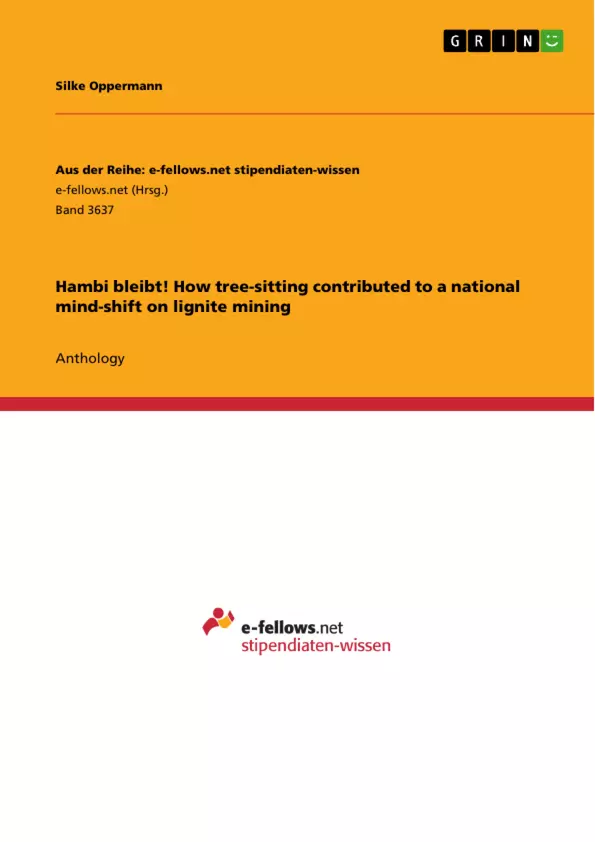This report aims to provide a comprehensive systemic overview of the lignite and forest history in NRW, analyzing the strategies employed by tree-sitters to protect the forest from clearance. Beyond the local context, the paper explores how these grassroots efforts sought to instigate a broader societal shift from a fossil fuel-based paradigm to one aligned with planetary boundaries.
The urgency for change is underlined by the environmental implications of lignite combustion, recognized as one of the world's major climate challenges. The least efficient fossil fuel, lignite poses a significant threat to biodiversity and terrestrial ecosystems, necessitating a reassessment of decisions made in the 1970s. The paper argues for a shift in focus – from protecting coal mines to safeguarding the environment, echoing the sentiments of the tree-sitters and civil society actors involved.
By investigating the actors and stakeholders in this struggle, including the tree-sitters, the environmental NGO BUND Landesverband NRW, and the energy giant RWE AG, the paper provides a nuanced understanding of the complex dynamics at play. It also explores the strategies employed, ranging from confrontational tree-sitting to legal action and societal awareness campaigns.
While the tree-sitters primarily relied on their bodies, commitment, and local support for resources, their impact transcended the local level. The paper evaluates the outcomes of these efforts, acknowledging the success in garnering national attention and contributing to the political discourse on lignite mining and climate change in Germany.
In conclusion, the Hambach Forest saga serves as a case study in environmental activism, highlighting the potential of grassroots movements to effect change. The paper contends that, even in the face of temporary setbacks, the persistence and determination of tree-sitters played a crucial role in shaping a national conversation on lignite mining and fostering a growing awareness of the need for systemic change towards a sustainable society.
Inhaltsverzeichnis (Table of Contents)
- Why change?
- Who are the actors and stakeholders?
- The grassroots movement of the tree-sitters
- The environmental NGO BUND Landesverband NRW
- RWE AG
- The North Rhine-Westphalian Government
- Which strategy is followed?
- The primary strategy of the occupants
- A small minority of the occupants
- The activists envision
- What are the necessary resources?
- The tree-sitters' main resources
- Material resources
- How did it turn out?
Zielsetzung und Themenschwerpunkte (Objectives and Key Themes)
This report aims to offer a comprehensive overview of the lignite and forest history of North Rhine-Westphalia (NRW) and analyze the strategies employed by tree-sitters in their efforts to protect the forest from clearance. Through this analysis, the report seeks to spark societal change, moving away from a fossil fuel-based society towards one that aligns with planetary boundaries. The report focuses on the events of the year 2018.
- The environmental and societal impacts of lignite mining
- The role of civil society actors in environmental protection
- The strategies and resources used by the tree-sitters
- The impact of the tree-sitting movement on public awareness and policy
- The challenges and opportunities for achieving a sustainable society
Zusammenfassung der Kapitel (Chapter Summaries)
- Why change? This chapter discusses the environmental problems associated with lignite combustion and open-cast mining, highlighting the need for a shift away from fossil fuels and towards a sustainable society. It also emphasizes the urgency of protecting ancient ecosystems like Hambach Forest and reducing greenhouse gas emissions.
- Who are the actors and stakeholders? This chapter introduces the key actors involved in the Hambach Forest conflict, including the tree-sitters, the environmental NGO BUND, the energy corporation RWE, and the North Rhine-Westphalian Government. It describes their respective roles and motivations in the conflict.
- Which strategy is followed? This chapter analyzes the strategies used by the tree-sitters, focusing on their confrontational approach through tree-sitting, direct action, and disruptive tactics. It also examines the broader implications of their actions for the climate justice movement and the transition to a sustainable society.
- What are the necessary resources? This chapter explores the resources utilized by the tree-sitters, highlighting their reliance on human resources like commitment, determination, and trust, as well as material resources such as construction materials, food, water, and climbing equipment. It also emphasizes the role of community support and donations in sustaining the movement.
- How did it turn out? This chapter examines the impact of the tree-sitting movement, highlighting its success in raising public awareness and influencing policy decisions. It discusses the role of media coverage, legal action, and the political climate in driving change. The chapter also acknowledges the limitations of the movement and the ongoing challenges for achieving lasting protection for the forest.
Schlüsselwörter (Keywords)
The key terms and concepts explored in this report include: lignite mining, Hambach Forest, tree-sitting, environmental activism, climate change, sustainability, fossil fuel phase-out, planetary boundaries, civil society, direct action, public awareness, policy change, and societal transformation.
- Arbeit zitieren
- Silke Oppermann (Autor:in), 2019, Hambi bleibt! How tree-sitting contributed to a national mind-shift on lignite mining, München, GRIN Verlag, https://www.grin.com/document/955764



